
The Aristolochiaceae are a family, the birthwort family, of flowering plants with seven genera and about 400 known species belonging to the order Piperales. The type genus is Aristolochia L.
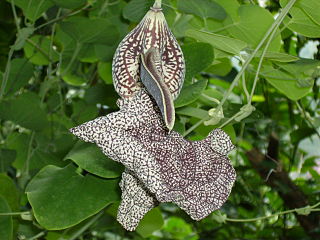
Aristolochia is a large plant genus with over 500 species that is the type genus of the family Aristolochiaceae. Its members are commonly known as birthwort, pipevine or Dutchman's pipe and are widespread and occur in the most diverse climates. Some species, like A. utriformis and A. westlandii, are threatened with extinction.
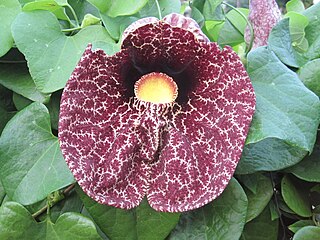
Aristolochia littoralis, the calico flower or elegant Dutchman's pipe, is a species of evergreen vine belonging to the family Aristolochiaceae.

Aristolochia rotunda, commonly known as smearwort or round-leaved birthwort, is a herbaceous perennial plant native to Southern Europe.

Aristolochia labiata, the mottled Dutchman's pipe or rooster flower, is an ornamental plant which is native to Brazil.

Ceratocystis fimbriata is a fungus and a plant pathogen, attacking such diverse plants as the sweet potato and the tapping panels of the Para rubber tree. It is a diverse species that attacks a wide variety of annual and perennial plants. There are several host-specialized strains, some of which, such as Ceratocystis platani that attacks plane trees, are now described as distinct species.

Aristolochia westlandii is a species of plant in the family Aristolochiaceae. It is found in China and Hong Kong, in valley forests in Guangdong Province at an elevation of 300 to 800 metres. The leaves are long, narrow and pointed. The flowers are bent tubes from 10–15 centimetres (3.9–5.9 in) long that grow from the base of a leaf. They are yellow with purple veins and blotches.

Aristolochia didyma, or yawar panga is a plant found in South America of the genus Aristolochia. It is a powerful purgative, sometimes used in traditional rites to purify the body a few days before an Ayahuasca session.

Battus polystictus is a species of butterfly from the family Papilionidae that is found in Brazil, Paraguay, Uruguay and Argentina. Male and female are less dimorphic than in related species as regards wing shape and pattern, but the male has a prominent pale yellow lengthwise stripe on the upperside of its abdomen.

Dendrobium plicatile is an orchid species of Asia. It was formerly treated as Flickingeria fimbriata in the genus Flickingeria.

Aristolochia macrophylla, Dutchman's pipe or pipevine, is a vine native to the eastern United States. Aristolochia macrophylla belongs to the plant family Aristolochiaceae and is found primarily along the Cumberland Mountains and Blue Ridge Mountains in the eastern portion of the United States, as well as Ontario, Canada. This species of plant has received considerable attention in the past few decades for the discovery of a potent compound called aristolochic acid, which has been the focus of debate due its harmful side effects.

Aristolochia arborea is a species of perennial plant in the family Aristolochiaceae. It is found from Mexico through Guatemala and El Salvador.

Aristolochia gibertii is a species of perennial plant in the family Aristolochiaceae. It is found in Argentina, Bolivia, and Paraguay.

Aristolochia eriantha is a species of perennial plant in the family Aristolochiaceae. It is found in Bolivia.
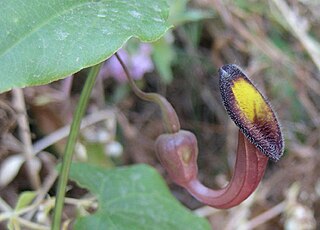
Aristolochia sempervirens is a species of perennial plant in the family Aristolochiaceae. It is found in the Eastern and Southern Mediterranean Basin, notably in Crete.

Aristolochia tricaudata is a species of perennial plant in the family Aristolochiaceae. It is found in Chiapas and Oaxaca, Mexico.
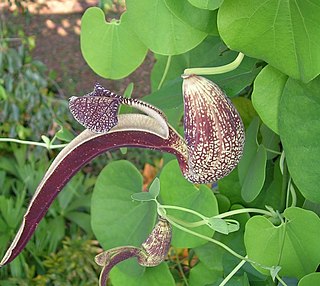
Aristolochia ringens is a species of perennial plant in the family Aristolochiaceae. It is found from Panama through Bolivia, Colombia, and Venezuela.
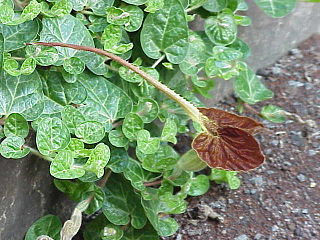
Aristolochia lindneri is a species of perennial plant in the family Aristolochiaceae. It is found in Santa Cruz, Bolivia.

Aristolochia pontica is a species of perennial plant in the family Aristolochiaceae. It is found in the Republic of Georgia.
Barbara Ambrose is a botanist working in the field of Plant Evolutionary Developmental Biology (Evo-Devo). As the Director of Laboratory Research at the New York Botanical Garden, Ambrose is a prolific scholar and leader and mentor in her field who is interested in patterns in plant diversity on macro and micro scales.


















